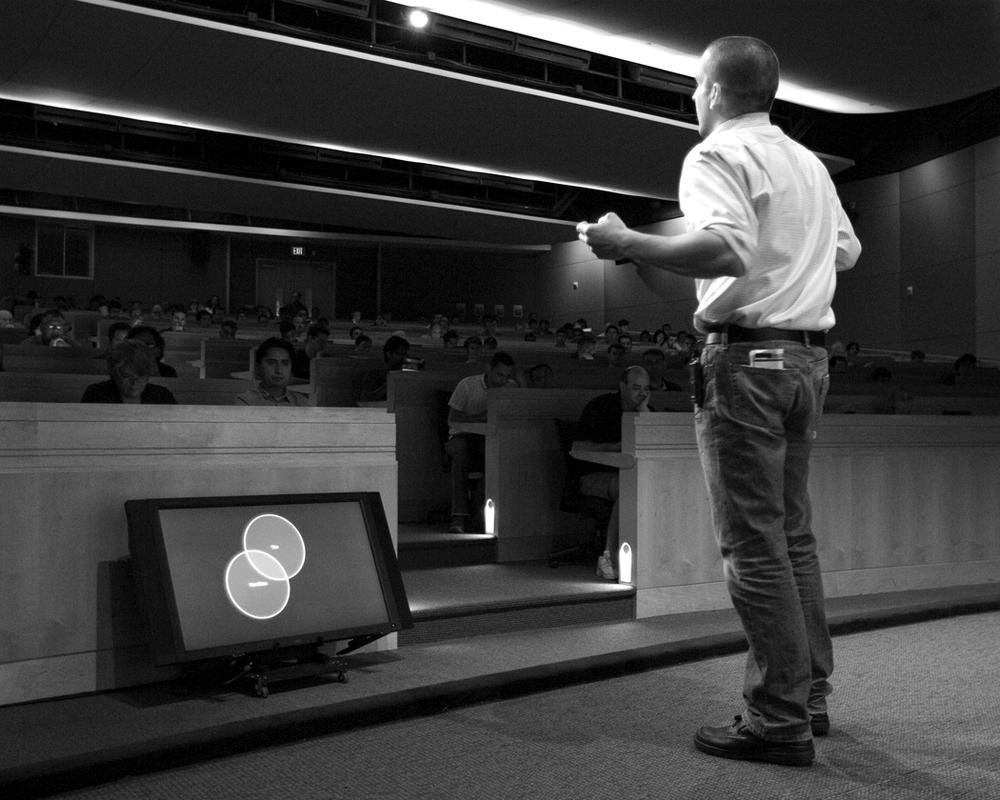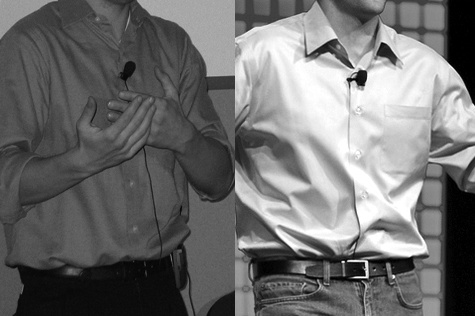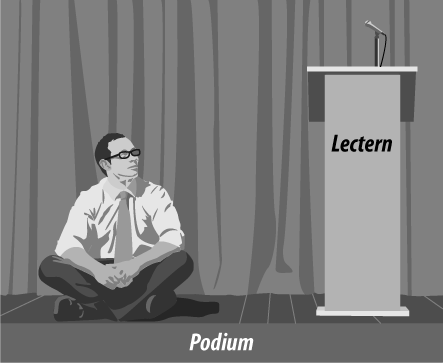Confessions of a Public Speaker (18 page)
Read Confessions of a Public Speaker Online
Authors: Scott Berkun
Tags: #BUSINESS & ECONOMICS / Skills

When you do anything difficult for a living, little things make a
big difference. Any reliable advantage I can get is one I always take.
Over the years, I’ve come across some that can help anyone, regardless of
how often you speak. Some require help from the venue you’re speaking in,
but most only demand arriving early and some extra time.
To connect
with an audience, I have to make as much eye contact as
possible. But this is a challenge when my slides are projected behind me
on a screen. To make sure the audience sees what I think they’re seeing,
I normally have to turn and look at the screen or stay behind the
lectern, limiting how much I can move or interact with the crowd. The
solution is to use what’s called a
confidence
monitor
. It’s put up at the front of the stage and shows me
exactly what’s on the screen, which is an enormous advantage (see
Figure A-1
). First, I don’t
have to turn around to see what’s on my own slide, preventing the rookie
mistake of having my back to the audience. Second, I can use my
peripheral vision to verify that the slide transition has worked
properly without having to look directly at the screen. With a remote
control, I can be almost anywhere on the stage and, mid-sentence,
advance a slide with a perfect voiceover transition.

Figure A-1. A confidence monitor where the crowd can’t see it.
PowerPoint and Keynote both have presenter mode features that
allow the confidence monitor to show not only the current slide, but
also a small version of the next, or even any notes you’ve
prepared.
It’s very hard to track time while speaking. There are too many
things going on simultaneously to remember to check the time and
calculate how much remains while giving your lecture. For this reason,
big events often place a
countdown timer up front next to the confidence monitor.
Some of these clocks also have three lights—red, yellow, and green—to
indicate how much time is left. Green is how you start, yellow means one
or five minutes remain, and red means you’re done. You don’t need fancy
technology to do this. Good hosts hold up paper signs that read, “10
minutes,” “5 minutes,” and “Wrap it up,” as appropriate. Of course,
speakers can take care of this themselves if they have the right
remote control.
Occasionally, you’ll see a speaker so unaware of the value of a
remote that he runs back and forth from center stage to the lectern,
only for the sake of advancing slides. This is called the “circle of
slide death,” the circle being made by the speaker on every roundtrip. I
used to be that guy. I hated remotes because I thought only pompous,
phony salesman-types used them. But I realized over the years that
working without a remote was just stupid. Without one, I had to find the
mouse or keyboard every single time I wanted my slides to do something,
and during that time, my focus switched from the audience to my gear.
Any time I have to focus on gear and not my message, I’m making a
mistake. Over 20 or 30 slides, the extra work of shifting focus back and
forth, and the little clicking sound of the mouse creating an idiotic,
unintended soundtrack, can kill whatever flow I worked so hard to
get.
Having control in your hand gives you complete freedom. You can do
whatever you want at any time—roam the stage, go into the crowd, stand
behind the lectern, or make a few points from the last row (but always
check with the tech crew, as wireless microphones can create feedback if
you leave the stage). Even if you don’t do any of those things, your
body knows you can and has one less restriction to worry about. Remotes
cost $20–40. Why not have one?
The best model I know of is the one recommended by Guy Kawasaki,
the
Logitech Cordless Presenter (
Figure A-2
). Its only
downside is it’s so big it’s hard to hide even in my large hands, but
everything else is done right. It has a built-in timer that will vibrate
as an alarm, letting you know when you’re running out of time.

Figure A-2. The Cadillac of remote controls: Logitech’s Cordless
Presenter.
The front row at lectures is like the Bermuda Triangle. No one
wants to sit there
for fear of being embarrassingly bored or not being able
to escape. But as described in
Chapter 4
, I want a dense crowd,
and I want it most packed where I am, near the stage. This
means a full front row works to my advantage. I often bring books to
give away during Q&A, but if the front is empty, I offer a free book
to anyone who is willing to move to the front. It always works, usually
entertains those who are too lazy to move, and makes the audience seem
much less threatening to me. (The toughest, scariest people seem
harmless when they are chasing after free things.) The more worried I am
about a talk, the more likely it is I’ll bring books (
Figure A-3
shows me with a
pile of my books). If you don’t have books of your own, nothing stops
you from buying good books someone else wrote on the topic you’re
speaking about and giving those away ($100 is money well spent if it
cuts your nerves and loosens up the crowd). The effect will be the same.
Do not give away ugly swag and junk. If you offer cheap things that no
one wants, your front row will remain empty, and you are stuck with
piles of unpopular items you couldn’t even give away.

Figure A-3. Have good things to offer people to fill the front row. Put
them out where they can be seen so it builds curiosity about what
you’re going to do with them.
Most events use
wireless microphones, which require clipping a lapel mike
to your shirt. I’m not a fan of fancy clothes for lectures (there are
better ways of showing respect for audiences), but dress shirts are the
best, most reliable way to clip on these microphones. On a sweater or
T-shirt, the lapel mike will pinch the fabric, which is easy to notice.
The goal of the wireless mike is to be as inconspicuous as
possible.
To help with this, you should always run the wire for the
microphone under your shirt, instead of letting it dangle over. There
are two reasons for this. First, leaving it out looks bad and is
distracting. Second, if you talk with your hands as I do, that dangling
cable is just asking for trouble. I have, when making a point, caught my
thumb on the cord, sending the microphone flying and making loud, awful,
embarrassing noises over the PA. You’ll notice the difference in
Figure A-4
.

Figure A-4. Tuck your microphone cord under your shirt. The trick is to
detach the cord from the box, drop it down your shirt, and reconnect
it once it’s through your shirt.
If you are on stage, you can assume you don’t need a
name tag. People know who you are. You’re the one with the
microphone. A
badge is distracting and can get caught in your hands like
the microphone wire. Good hosts catch this before speakers go on and
remind them to take off the name tag.
It’s a gripe among theater types, but the podium is what you stand
on. The lectern is what you stand behind. If you want to annoy your
public speaking friends, point out every time they say podium when they
mean lectern (
Figure A-5
).

Figure A-5. Do not stand behind the podium. You will look very silly if you
do.
These days, many presentations are videotaped, which means it’s
possible your real audience is not the crowd in front of you. Instead,
it’s the people who will watch online in the months and years that
follow. Many more people watch TED talks over the Internet than attended
the conference in California. If you’re smart, you will treat your
cameramen well. They can do all kinds of things to make you look or
sound stupid, so get on their good side. Ask their names, ask their
advice, and treat them like people, not servants. When you’re preparing,
craft your material and slides
with the web audience in mind. You’re projecting not just
to the back row in the room, but to the people who will watch on a tiny
window on a computer monitor. Often, people watching online have no
sense of how good or bad things were live (the sense of dead air or a
tough crowd gets lost on video, which means sometimes you can bomb in
real time, but do very well online). When Stephen Colbert presented at
former president Bush’s press dinner, it was a disaster (it’s also a
notoriously tough crowd). The room hated him. But the talk was a huge
hit on the Web.
